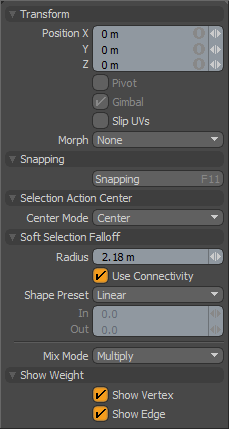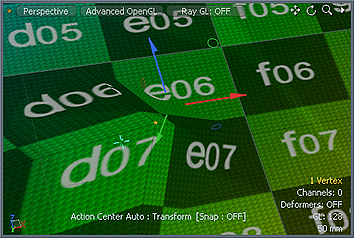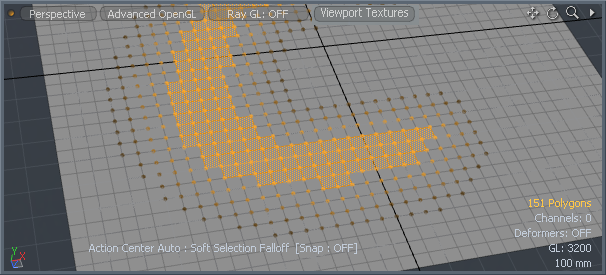Soft Selection Move
The Soft Selection Move tool is a deformation tool that moves or translates the selected geometry rigidly, while gradually attenuating the translation outside of the selected area defined by the Radius value for the Soft Selection falloff.
Using Soft Selection Move
You can find the tool in the Model layout, in the Deform sub-tab of the modeling toolbox (sometimes as a sub-tool of one of the other Soft Selection tools).
Click the Soft Selection Move button to activate the tool, then click in the viewport to reveal the transform handles. As you increase the radius, the softness of the transformation also increases.
Besides manipulating the handles in the 3D viewport, you can edit the values in the tool's Properties panel. The following options are available for the Soft Selection Move tool:

|
Transform |
||||
|---|---|---|---|---|
|
Position X/Y/Z |
Displays the offset distance for each axis (calculated from the position the object was in when you activated the tool). When adjusting an object interactively in the viewport, the Position values indicate the current offset distance applied. |
|||
|
Pivot |
Disabled for the Soft Selection Move tool. |
|||
|
Gimbal |
Disabled for the Soft Selection Move tool. |
|||
|
Slip UVs |
When enabled, edits applied to the geometry do not change the existing UV map. UV values are generally fixed to specific vertices; therefore, further edits to the geometry may warp, deform, or otherwise distort the UV values in undesirable ways. When this happens, you may need to adjust the map or to redo it altogether. To avoid this undesirable result, you enable Slip UVs so as to not disturb any existing UV mapping applied to the geometry.
|
|||
|
Morph |
(Only available in Component modes) Determines how Modo treats stored morphing information when applying transforms (such as the Move, Rotate, or Scale transforms) to geometry. There are three options for controlling how Modo deals with the morph map vertex data when applying any transforms. • None - Transforms selected (visible) morphs independent of their source, but does not affect unselected morph data.
• Transform - Transforms morph data along with the base mesh.
• Keep Positions - Converts morph data into an absolute morph map. All vertices retain their pre-transformed positions. Note: In previous versions of Modo, to transform a morph along with its base, you needed to select it in the Vertex Map list. If you didn't, when Modo recalled the relative morph map data, it would produce distorted, undesirable results; therefore, it was easy to accidentally spoil a model. To remedy this problem, current versions of Modo have three options to deal with the morph map vertex data. |
|||
|
Snapping |
See the Applying Snapping topic for details about this feature. |
|||
|
Selection Action Center |
See the Specifying Action Centers and Falloffs topic for information. |
|||
|
Soft Selection Falloff |
||||
|
Radius |
Determines the range outside of the selected edge to attenuate the falloff. |
|||
|
Use Connectivity |
When enabled, affects only single-surface, connected elements. Modo ignores unconnected elements within range. |
|||
|
Shape |
Controls the strength of the falloff's influence along the extent by using a shape preset. • Linear - Attenuates the falloff evenly across its range.
• Ease-In - Strengthens the falloff toward the start position.
• Ease-Out - Strengthens the falloff toward the end position.
• Smooth - Strengthens the falloff toward the center of the falloff.
• Custom - Fine tunes the strength of the falloff based on the In and Out values. |
|||
|
In/Out |
Determines the strength of the falloff nearer to the start or end position. |
|||
|
Mix Mode |
Defines how each falloff interacts with the other(s) in instances where there are multiple falloffs applied to a transform (by using Add in the Falloff menu). |
|||
|
Show Weights |
||||
|
Show Vertex/Show Edge |
When enabled, displays indicators of vertices or edges for a visual reference about the Soft Selection falloff. The image below shows Show Vertex enabled:
|
|||


